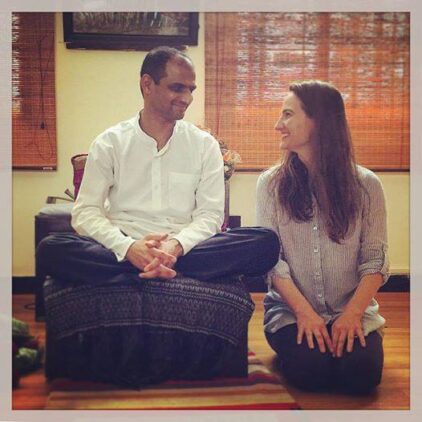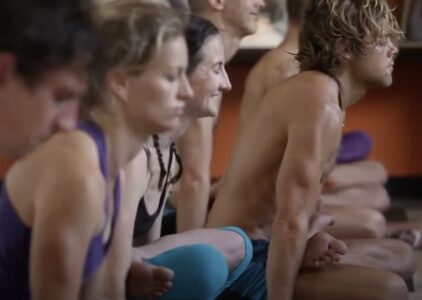I didn’t hear the first whisper of Krishna until the age of 22. A field was created by the way we said his name. I am only realizing now, 25 years later, that this field has held dear friends to me all this time, and very slowly showed me how to be a friend in return.
Here is how it happened. Halfway into my bachelor’s in philosophy, my mentor Dr. Fost started talking to us about divine play. Lila. It was I tiny liberal arts school near Portland, Oregon. Philosophy class would have 2-5 people in it and we were only allowed to read original texts (20-80 pages per day), no commentary. We met most days in a heavy high-ceilinged Greek Revival hall built in 1928. Over the course of that year, my little mind started to move towards the teachings of Advaita Vedanta. By senior year, when the philosophy club got a tranche of cash for a special event, I convinced them to bring an Advaita scholar to campus. Eliot Deutsch. A translator of the Indian sages for western mind, founder of the discipline of Comparative Philosophy. He would teach us about nonduality.
So he came, all the way from Hawai’i. I was his little host, walking him across dewy lawns to his lunches and lectures, watching the way he greeted our humble college. On Wednesday night, he Delivered. It was the intellectual event of the year, and none of us understood more than half of what he said in the third-floor conference hall overlooking our grove of mossy 200-year-old oaks. It got contentious! A hot fight about play, between my mentor and his colleague from English. Sigh. I was geared up for a full serving of enlightenment the next night, but what we got was something entirely different.
Eliot made us forget the intellectual knots of metaphysical debate; let us think deeply about friendship. His talk on “creative friendship” was nothing less than a peak experience, an epic high in the realm of ideas. He used that lecture to enclose us in the same field of intellectual love that contained his entire scholarly life.
What I think I remember is the idea of the super-best-friend. Krshna as the one who loves Arjuna into the best version of himself, mischievously and fiercely; who makes his own hard sacrifices and takes no bullshit on the way. One who creates whole realities like this, with the tool of friendship, has known one thing: how to be One who Loves. Eliot’s term, if I remember? All action, it is the expression of a love that cannot merely stay still – undifferentiated – nondual. We are not—he submitted—enslaved to our karma. Friendship is a holy vehicle of human choice wherein we create whole worlds. If we have love.
The bitterness from the night before transformed into a field of eyes sparkling for each other.
What matters now about that night 25 years ago is that Eliot created a field of creativity—invoked it explicitly and filled it with goodwill. The highest form of philosophy, he was saying, is shared novelty. Some of the most cherished people in my life today were in that room.
——————————–
The same is true of all the Mysore rooms I’ve been in where the spirit was strong. My teachers’ rooms, specifically. If Sharathji was holding them, they were fields of consciousness and play, fields of internal battle, and for those who were ready they were also fields of creative friendship. THIS is the change angent: the consciousness field itself. Not the things (postures) in it.
This topic is too vast to discuss. But it’s coming to the fore, awkwardly, in words because I’m seeing now that my work going forward is to try to constitute fields of shared consciousness. To the degree that I am able. That’s the transmission I received, more than anything in particular. How to hold a space.
A Mysore room is so many things, and around all of them, necessary for the radiance to happen, there needs to be a container. An electrificed charge of deep silence that drives the senses inward, so deep and so much that the heart sends out its web to hold us together with our people.
Technically, there are things that increase the chances of a field springing forth to hold a group. Think about the way our teachers did it: to join the field, you commit for a month of shared time and space; you become cohort of spiritual friends; the group follows a clear discipline together with a lot of shared silence; each person should infuse wisdom teachings into each day. And within all this, with luck, the durable matrix of connection becomes extra bouncy and resilient through the crucial practice of just hanging out.
For the first ten years of teaching our local Mysore program in Ann Arbor, I’d also take an away-workshop every so often for a teacher who I mentored. Instead of going many places, I just went back to the same handful of small shalas every year.
This is because Sharath was extremely skeptical of workshops – they increase teacher ego tremendously, because we get treated as special on the road. What he wanted for us was the mundane nature of Mysore style – that we constitute a home program and build the field. Workshops were ruining the practice, it was often said.
The best students still say this. I got to hear Hamish give this warning to us kids over dinner again in November. Oh yeah. Thanks man. Let’s not forget.
For those first ten years I broke this excellent rule, and badly. My concession was to keep the spirit of it through a commitment to only visiting a few of the same places repeatedly. Until they grew bored of me. Meantime, with each visit, I would be even more delighted by them. It was tremendous. My shy, loyal heart loves a long duration. I worked so hard following that rubric, and loved it all so, so much. Thank you, all of you who joined me there.
Each visit, the host teacher would have them write me a letter, to a no-reply account called AJPhoneHome. Say anything, free associate, tell me what you want to study this weekend; it is all confidential. I’d read the whole sheaf of emails twice on the plane, using my ethnographic data analysis training to pull out common themes. That is how I could guess what to put into the container of our talks together.
On Friday evening, our first meeting would just be the ethnographic report. I’d simmer it all down to the main 2-4 key themes in the letters. It was never not beautiful, for me the reader of the leaves and for the students who made them. A big, comforting, hilarious mirror. I loved looking into it and seeing all of them.
The field of practice within a single shala ways always TIGHTLY coherent. People practicing silently together, but stitching the 8-limbed method into their own life path in a way uncannily on theme for another person in the opposite corner whose name they didn’t even know yet.
The whole point of sitting together was to throw light on the web of connection that was already there, glinting that radiance off of a few particular jewels, and then shut up again about these things for a year.
To work, this all had to be unscripted. An agenda from the facilitator (me) would kill the organic revelations within the field. The point of these meetings was not to impart knowledge – I had none. It was to see the field they already had created through their shared consciousness, rejoice in our awareness, and allow new positive intentions coalesce at the intersections of each web.
—————————————-
At our home shala in Michigan, I do none of this. I just show up. We all do. That’s it. Yesterday over chai and transportive cardamom Madelines, after Led Primary, we were talking about how the world is so hard now. Ukraine and Gaza. And the uncertainty. Untold future wars. The deluding of the mind, the aggression in the zeitgeist, the unbearable suffering of Beings.
I feel a physical ache in my heart now, often. To feel the world now in a realistic way, without pretending it’s something else. This is the feeling of staying connected, and staying real.
Something that digested yesterday with the chai, as we shared how we feel this ache in the heart, is a specific way that it helps to have a shala.
Ours is both local and virtual, so the lives that intersect in our meetings circle the whole globe. Many aspects of this world-moment are knit into our ashtanga container. Within this shala, we were thinking about how each of us knows the single life line of individual friends. People we know to be alive to their lives; spiritual friends who are on an 8-limbed path that breathes us all together and apart.
What helps me, above all, is to sink my awareness into the knowledge of just one or two of these beautiful, intentional lives. To do “find my friends” on the spiritual plane, sensing the truth, goodness and beauty that this One traces onto the planet with their life. Just today. How do they move through this world today?
Here we are. The crisis roars; the wars are real. And friendship by friendship, creativity holds its own field. There are Ones finding a measure of liberation by taking action from love. We suspect, in our shala, that meditating on, cherishing, just a single friend for who they are can be enough to hold the aching heart in balance. And a whole shala of spiritual friends over long time, it makes a bright universe.



